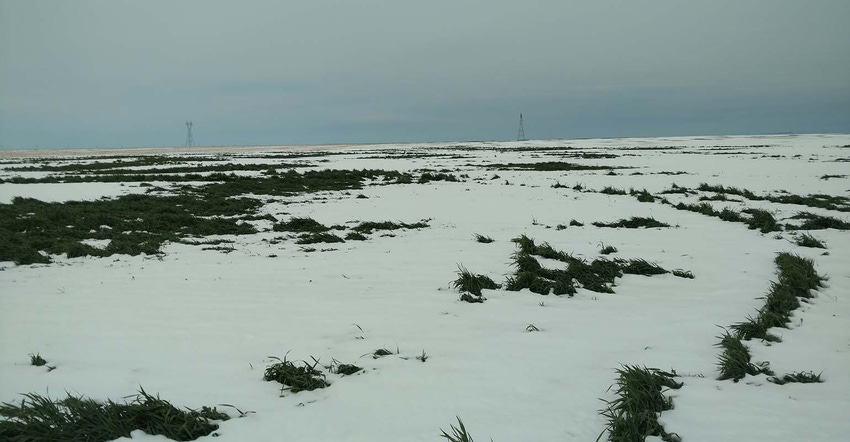
On the Alec Horton farm in Leoti, Kansas, about 40 miles from the state’s border with Colorado, wheat was still covered with snow on Wednesday, three days after a storm dropped up to 18 inches of the white stuff throughout western Kansas.
Despite the bleak conditions, Horton remains hopeful much of the crop can bounce back. The plant stems were green and pliable and could recover once the snow melts. There will be some wheat with broken stems that probably will not recover.
Most of Horton’s wheat was in the “boot” stage and had not yet produced a grain head, which may help with the recovery. Early this week USDA said 44% of the Kansas crop had headed and those fields hit by the storm may be at a greater risk of damage.
“I felt devastated and sick to my stomach,” Horton said when he first saw the snow-covered fields immediately after the storm. “But, driving around today and looking at the fields, it seems enough of it will bounce back so that we will harvest some wheat.”
While Horton expects some yield loss, he said it will be a week or more before accurate assessments can be made.
Kansas City hard red winter wheat futures rose sharply after the Sunday storm with the lead May contract setting a two-month high of $4.61-3/4 a bushel on Tuesday and the new-crop July contract peaking at $4.74-3/4. Since then prices eased from that peak as investors await the damage assessments.
“It is wait and see. We just don’t know yet,” said A. J. Foster, the area agronomist for Kansas State University in Garden City, Kansas. “One thing about wheat is you never bet against it.”
In the crop’s favor is the moisture the snow will provide. The melting snow should seep into the soil and aid the crop’s recovery and forecasts have warmer weather by this weekend. In addition, wheat plants have several stems, or tillers, and there is hope that the less mature tillers will recover and produce grain.
“I think there is going to be some yield loss, but the question is now much. I think it will take at least a week to know,” said Lucas Haag in Colby. Haag is the northwest area agronomist for Kansas State University.
The snow is only part of the wheat’s problem. Much of the crop is western Kansas is infested with wheat streak mosaic, a viral disease that can hurt yields. The condition was detected in the fall and was apparent this spring.
“It is mostly in the western part of the state. We had a warm winter. The warm temperatures are conducive for the wheat curl mite, which spreads the disease,” said Foster.
Low wheat prices had Kansas farmers planting fewer winter wheat acres last fall, however good moisture in late winter and early spring had raised hopes for good yields. USDA in March reported 7.5 million acres of Kansas this year, down from 8.5 million a year ago and 9.2 million in 2015.
Before the storm, Kansas wheat was rated 52% good to excellent. That dropped to 49% the day after the storm, but more accurate condition ratings are expected in the coming weeks once the snow melts.
About the Author(s)
You May Also Like




